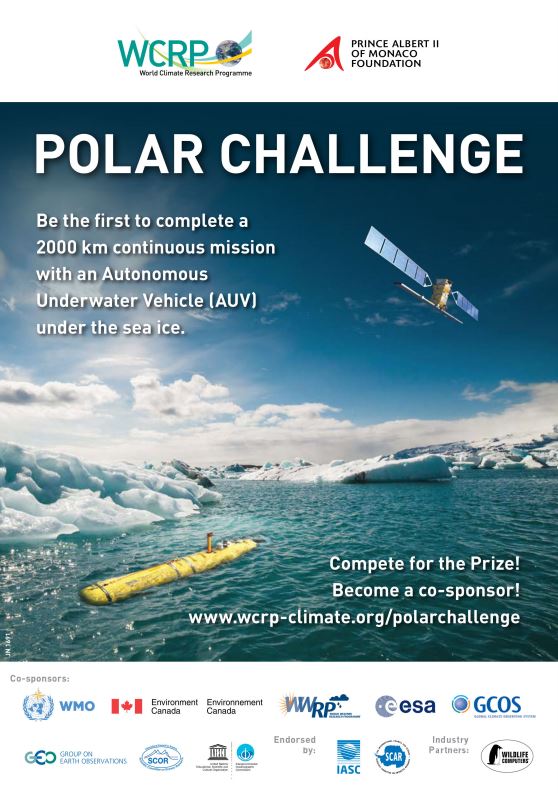This week at the This week at the Arctic Science Summit Week the World Climate Research Programme (WCRP) and the Prince Albert II of Monaco Foundation announced the launch of a new Polar Challenge to develop an Autonomous Underwater Vehicle (AUV) capable of completing a 2000 km mission under the sea ice in the Arctic or Antarctic.
The aim of the challenge, which includes prize money totalling 500 000 Swiss francs, is to stimulate the innovation of new monitoring tools for the polar oceans, to complement satellite observations and ultimately expand scientific research capabilities and climate services in both the Arctic and Antarctic.
Vision and Mission
A new paradigm for long-term under-ice observations towards a cost-effective, autonomous and scalable ocean monitoring network for the Polar regions
The cryosphere represents a major indicator of global climate change and plays a fundamental role in climate feedback. Despite numerous model improvements, the reliability of long-term climate change outlooks in Polar regions is severely limited by the lack and cost of systematic in-situ observations of the sea-ice and underneath.
Traditional in-situ ocean observations in Polar regions are inherently expensive and sparse, even more so under the sea-ice. A new paradigm is required to complement remotely sensed Earth Observations. Motivated by the potential scalability, limited risk and cost-effectiveness of emerging autonomous underwater vehicles (AUV) such as underwater gliders, WCRP is stimulating progress in this area by developing a Polar Challenge to push the boundaries of existing observing systems and scientific knowledge in both the Arctic and Antarctic.
AUVs of different kinds are already used in an operational context around the world in ice-free zones, and they surface on a regular basis to get a GPS fix and to transmit environmental data in near real-time. They are able to collect crucial and high quality oceanographic observations (such as temperature, salinity, chlorophyll, pH, etc) at lower cost compared to conventional observing systems.
Under the sea-ice, the operating range, positioning and data transmission represent major challenges for current underwater vehicles. The integration of recent progress regarding power systems and navigation techniques for example would expand significantly the range of applications of such vehicles, currently mainly limited to the open ocean.
The WCRP would like to promote technological innovation (endurance, positioning, data collection, etc) towards a future cost-effective, autonomous and scalable observing network for ice-covered ocean regions based on a fleet of such platforms, similar to what ARGO has accomplished for the open ocean.
If successful, this initiative will make a tremendous impact in shaping climate research in Polar regions. It will extend substantially the current scope of applications of AUV technology in the Arctic and Antarctic. New collocated multidisciplinary data sets of sea-ice and under-ice properties at unprecedented temporal and spatial resolution far into unexplored territories could revolutionize our knowledge of e.g. heat fluxes and storage, fresh water exchanges, carbon sequestration and ocean acidification in those regions. The proof of concept could be scaled up into a game-changing ocean monitoring network for the Polar regions.
This effort is aligned with WCRP research priorities, in particular the Grand Challenge on Cryosphere in a Changing Climate and the Grand Challenge on Regional Sea level Rise. It represents also a definite contribution to WWRP and WMO polar initiatives and is expected to benefit the wider stakeholder community (weather, ocean, environment, safety, security, transport, energy, tourism, etc).
Read more here.

